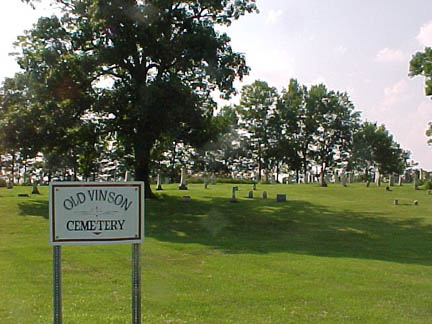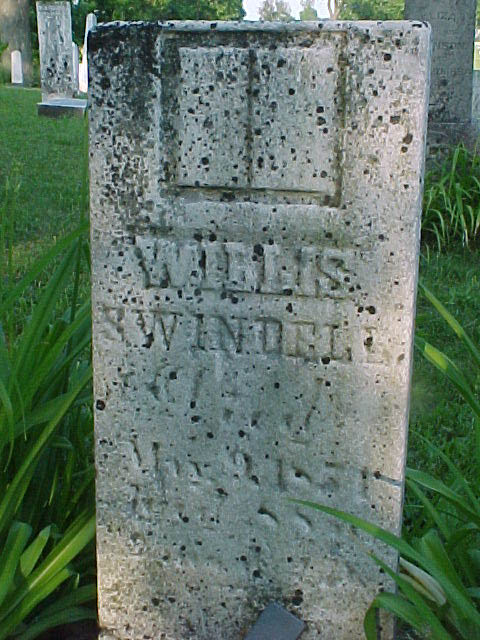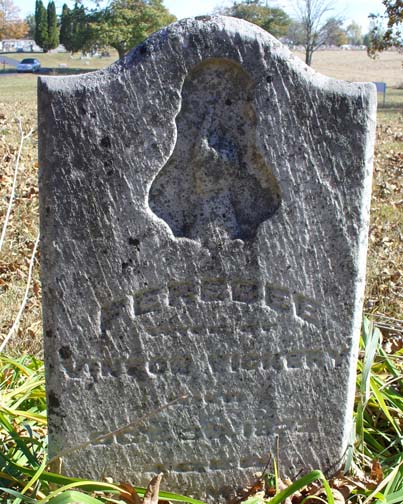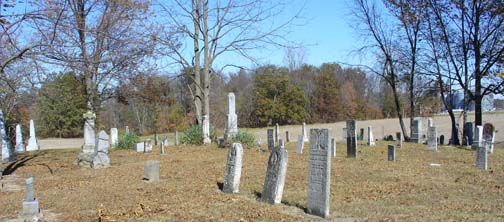|
Pioneer
Cemeteries and Their Stories, Madison County, Indiana |
 |
|
Pioneer
Cemeteries and Their Stories, Madison County, Indiana |
 |
aka New Vinson/Shinkle/Summitville
Location: west side of CR 100E, between CRs 1450N and 1500N
 The Old Vinson Cemetery has seen a lot of
changes in its one hundred and fifty plus years. It still is located on a
hill south of Summitville, but the cemetery in the 19th century used to be
approached from the
west; now it is approached from the east. The 1876 plat map for Van Buren
Township shows this cemetery located on the east side of the old Fort Wayne
Trace. This settlers' "highway" would have been the service road.
The cemetery
gate and/or drive would have been on the cemetery's west boundary, and
people would have entered from this direction. In fact, the old
gravestones all face the west. The Fort Wayne Trace has long since
disappeared, swallowed up by the surrounding farmers' fields; however, a slight
depression, showing where it used to run, can be distinguished in the grove of
trees on the other side of the west boundary fence in the southwest corner of
the old section.
The Old Vinson Cemetery has seen a lot of
changes in its one hundred and fifty plus years. It still is located on a
hill south of Summitville, but the cemetery in the 19th century used to be
approached from the
west; now it is approached from the east. The 1876 plat map for Van Buren
Township shows this cemetery located on the east side of the old Fort Wayne
Trace. This settlers' "highway" would have been the service road.
The cemetery
gate and/or drive would have been on the cemetery's west boundary, and
people would have entered from this direction. In fact, the old
gravestones all face the west. The Fort Wayne Trace has long since
disappeared, swallowed up by the surrounding farmers' fields; however, a slight
depression, showing where it used to run, can be distinguished in the grove of
trees on the other side of the west boundary fence in the southwest corner of
the old section.
Since the New Vinson Cemetery has taken charge of its predecessor, land has been acquired and added to the east of the old burial ground. The approach has been changed, and the gates and drives are now off of CR 100E. The old markers seem to have their backs turned on the modern age. They are looking onto a wide expanse of farmland instead of the old trace's travelers and wooden vehicles. All the activity is now occurring from the opposite direction, behind their stone faces. The Old Vinson sign at the back of the north section of the new part alerts visitors that across the little meadow and up the hill the old markers are waiting--a little disgruntled in appearance, perhaps, but friendly enough.
|
Taken from the old section, looking east, this picture shows the Old Vinson's gravestones facing west while the gravestones in the new section, which can be seen in the far distant background, face east. The original access was from the now-abandoned Fort Wayne Trace along the west boundary of the Old Vinson section. |
|
Patriarch of the Madison County Vinson family was Elijah who was born in 1788 and died in 1849. He is on the burial list below. There are over eighty of that surname recorded for the entire burial ground. The 1876 plat map shows members of the family owning over 500 acres surrounding the little cross designating the cemetery's location. The family, of course, began this private burial ground, but out of 19th century tradition and general consideration, once a graveyard was begun, its services were offered to the neighboring farmers. Over the decades other settlers became represented: the Allens, Cartwrights, Dobsons, Thurtsons, Vickerys, and Parkhursts among others. Various stones for the Vinson family are displayed below.
|
|
|
|
|
|
|
|
|

The Cartwrights, below, and Blades, above, are given special distinction by the 1880 History of Madison County, Indiana as being among the first pioneers to the township between 1830 and 1836. Both settled in section 31 which is just south of the cemetery. James and wife Elizabeth Blades have markers side by side, above. She died in 1850, and he in 1872. Thomas Cartwright and his wife Basheba are commemorated on the tall pillar, below right. Miles Cartwright, below middle, is not recorded on the burial list by some oversight, and Spencer's nicely preserved stone, below left, states that he died in 1847.
|
|
|
|
|
One of the oldest, most honored stones facing west in the old section is that of Willis Swindell. Willis served in North Carolina's militia in the later years of the Revolutionary War. His service is recorded in the Supplement to the DAR Index of Patriots. He was born in Hyde County, North Carolina, in 1763, and after the Revolution, he and his family first moved to Wayne County, Indiana, and later to Van Buren Township in Madison County. Willis lived to be eighty-eight years old. He died in 1851 and was survived by his son Ashley. Willis Swindell's stone is in excellent condition. His gravestone was photographed and used by the Anderson Herald-Bulletin for a June 2002 and July 2010 for articles on Revolutionary War soldiers buried in Madison County . Willis's stone also has the distinction of the being the only stone for a Revolutionary War veteran in Madison County that is intact, at its original location, and still legible. |
 |
The Allen family were some of the earliest settlers to Van Buren Township. Reuben, Harrison, and Hiram are listed individually in county historian Samuel Harden's The Pioneers as among first land owners in the area. The 1876 plat map shows members of the family owning about the same amount of land as the Vinsons, to the south and west of Summitville. The Allens had one of the first schoolhouses in the township. Evidently, they also have descendants researching their genealogy since Abram's stone, below right, has been decorated.
Three of the Allen stones pictured have the weeping willow motif above the names. This symbol stood for the mourning of those left behind. Traditional figures at the top of flat tablet-type stones, like these, were popular in mid 19th century.
Later in the time period, three dimensional grave markers became popular. Jos. A. Allen's scroll with leaves, below center right, is draped over a tree trunk. The tree represented the family and its roots or heritage. His wife's scroll over a podium, below center left, has a rose which symbolized love. Also fashionable in the late 19th century were architectural forms such as Jane Allen's structured pillar, below right.
|
|
|
|
|
|
|
|
Genealogists seem to abound in Van Buren Township. Center below is the relatively new marker for another first family, the Plows. Henry's original stone is below left; Ann's original is missing. The tall stone behind the replacement is that for Arthur Plow who died in 1850 at fifteen years. Perhaps Arthur was Henry and Ann's son. Another new stone provided by descendants is at right for Mary Reavis, 1803-1854.
|
|
|
|
The Moores were also among the very first to inhabit the area. John S. Moore moved from North Carolina in 1836. His wife Mary J. died in 1881. On her stone above the hand pointing heavenward is the phrase "Gone Home." Nancy's stone, right--one of the few needing reset at this cemetery--is one of the earliest. She was the daughter of Samuel Moore, and she died in 1845 at nine years of age.
|
|
|
The Vickery family must also have been among the early settlers. Vincent's stone, below left, is dated 1853, and he was fifty-nine years old, making his birth year around 1794. Ferebee, P. Sr., David, and Willis follow left to right.
|
|
 |
|
|
|
The Kents, below, were from that early time period. Almira's stone, right, is one of the oldest legible markers at the Vinson. She died "Apr. 11, 1842." Mahlon's stone, left, has the death year as 1859 while Harriet's, middle, reads, "wife of H.V. Kent died Jan. 18, 1854, 35 yrs. 11 mo. & 15 days."
|
|
|
|
|
|
Another first family, the Broyles, have stones with multiple interesting images. John's pillar, left, has a hand pointing up. This symbolizes that his soul is heaven-bound. The book in relief is the bible. John, who died in 1861 at twenty-one, was the son of Thomas. Hannah's Victorian style marker records that she was the wife of Joseph Broyles. She died "Nov. 1, 1869 aged 26 Y & 7 D." Her soul is represented by the bird flying upward toward heaven. At the top the hands of God are depicted receiving her through pebbled clouds. The drape with tassels stands in this case for the veil of mystery separating the physical world from the spiritual. |
|
|
|
Couples have several different ways to represent their partnership. Like the Blades above, Adam and Mary Jane Parkhurst have markers, right, set next to each other. These stones are also of similar carving and design--obelisks. The obelisk in memorial symbolism stood for the spiritual connection between heaven and earth. The double pillared monument, left, for Rebecca Thurston and her husband has within the arch hands that are clasped. This symbol says that while the couple shared a supportive life on earth together, they will also meet in heaven. |
|
There are only two Atwells listed on the burial records for the entire cemetery, but they do have stones in this old section, which places these residents among the people who helped turn this untouched wilderness into a community. The stone, left, for James is still very crisp and legible: "James T. Atwell died May 28, 1871 aged 74 Y. 2 M. 20 D." James's birth year would have been circa 1797. His son Joseph, who died in 1866, was thirty-one when he passed on.
|
|
|
Other families that contributed to Van Buren Township's development left members reposing at the Vinson Cemetery. Hannah Stanley's pretty early Victorian marker is left; Lavana, "wife of Robert Carlton," has a broken tablet, middle; and Almira's stone needs resetting. The dove at the top symbolizes her innocence; she was just two years old when she died in 1876.
|
|
|
|
The tablets for other mid century female family members are left to right Martha Noland, Mary Trent, and Martha Dobson.
|
|
|
|
The simple stones for Nathan Jones, John Helm, John Weers, and Henry C. Williams are below, left to right.
|
|
|
|
|
The more complex styles of memorial architecture are shown by the markers for Phillip Creamer, Nicholaus Weers, Ransom Sisk, and James Ayers, left to right.
|
|
|
|
|
As in many burial grounds operating in the mid 19th century, there are veterans from the Civil War. The Vinson has the distinction of having not only several veterans from the northern states but also Joseph Kirkpatrick, below left, who fought in the Confederate States Army. James. M. Bragg, below right, from Co. O. 9th Indiana Infantry, represents his comrades.
|
|
|

Above, looking from the old section northeast toward Summitville; below, looking into the old section from the drive in the new section;

Click here for a list in pdf format of burials with headstones.